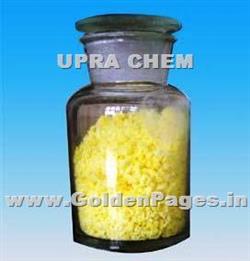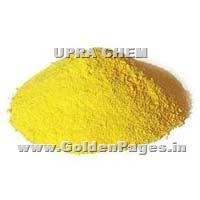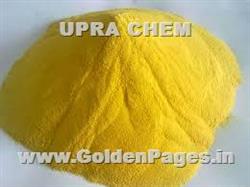UPRA CHEM P.LTD.
Featured Products
Highest quality standards are achieved through the implementations of latest technology, decades of experience and everlasting moral values , which have helped us to retain our customers as well as multiply them.
Welcome to UPRA CHEM P.LTD.
Anhydrous Aluminium Chloride

Anhydrous Aluminium Chloride:
Anhydrous Aluminium Chloride is a versatile Inorganic Chemical and finds application in a large number of Organic and Inorganic Chemical Syntheses and Reactions.
It is mainly used as Catalyst for the Chemical, Petrochemical and Pharmaceutical industries as also an auxiliary in the production of dyes and in the paper and textile industries.
Description :
Nature: Pale/golden yellow or grey crystalline substance. Very hygroscopic.
Trade name: Anhydrous Aluminium chloride, Aluminium Chloride, aluminium trichloride
Formula: AlCl3
Molar mass: 133.34 g/mol
CAS No.: 7446-70-0
EINECS No.: 231-208-1
SPECIFICATION:
Assay-Purity AlCl3 % : Minimum 99+ %
Water Insolubles % : Maximum 0.05 %
Non-Volatiles % : Maximum 0.90 %
Free Aluminium ppm : Maximum 50
Iron ppm : Maximum 150
Zinc ppm : Maximum 25
Copper ppm : Maximum 25
Lead ppm : Maximum 10
Cadmium ppm : Maximum 5
Potassium ppm : Maximum 10
(Slight variation may occur between the different grades)
Particle Size - Grade I : < 2 mm
Grade II : 2 mm to 9 mm
Grade III : 9 mm to 20 mm
Grade IV : 20 mm and above
Grade V : Mixed Grade
Properties
Reacts with moisture in the air or water to form hydrogen chloride, which has a pungent odour. Dissolves in alcohols, ethers, esters, and many other polar, organic solvents.
In some cases, adducts are formed.
Solubility in water (20 °C) 450 g/l
Melting point (2.33 bar) 192.5 °C
Sublimation point (1.1325 mbar) 181.2 °C
Bulk density approx. 1200 kg/m3
pH-value (100 g/l, 20 °C) 2.4
Application
In the chemical, petrochemical and pharmaceutical industries:
As a catalyst or as a component of catalyst systems for a number of chemical reactions, examples of which are as follows:
Reactions of aromatic hydrocarbons with alkyl halides and other halocarbons, alkenes, primary and secondary alcohols, various alkanes, carbonyl halides and anhydrides, carbon monoxide and hydrogen chloride, epoxides, unsaturated amines.
Reactions between unsaturated compounds, e.g. alkenes with hydrogen sulphide, isoalkanes, alkyl halides, acid chlorides, and (methyl) acrylates, butadiene and butadiene derivatives with formaldehyde, alpha, beta-unsaturated carbonyl compounds with vinyl ethers, alpha, beta-unsaturated aldehydes with alcohols or acetic acid.
The isomerization of alkanes and alkenes, alkyl-substituted aromatic compounds, alkyl and aryl halides.
Disproportion and transalkylation of alkyl-substituted aromatic hydrocarbons.
Disproportion of halocarbons.
Dimerization and polymerization of alkenes.
Chlorination of chloroalkanes, chloroalkenes, and other aliphatic or aromatic compounds.
Additive in the production of titanium dioxide pigments from titanium tetrachloride.
Raw material for the production of special aluminium oxides .
Auxiliary in the synthesis of dyes .
The paper industry uses it in the production of parchment ; and the textile industry for carbonizing wool .
Storage
Aluminium chloride anhydrous must be stored in a cool, dry place. Before the drums are opened, they must be aired through the lids and tightly closed again. Unopened, original containers may be stored for 12 months. If the storage period is longer, caking can be expected.
Leakages of the bundles cause an increase of pressure by reaction of aluminium chloride with air humidity to toxic and corrosive hydrogen chloride. Therefore the bundles have to be controlled in regular intervals, formed positive pressure that has to be discharged by careful opening of the vent screw. During this operation the personal protection equipment, especially respiratory protection, is to be used (for further information, please have a look to the safety data sheet).
Aluminium chloride does not burn, but it should not be stored together with combustible materials, so that the possibility of a reaction between water and aluminium chloride is excluded when extinguishing a fire.
Packaging/Delivery
The product can be supplied in the following forms:
-
ground
-
sieved
Can be delivered as follows:
-
Silsack Bag with PVC Liner
-
MS Drums
-
Jumbo Bag General-purpose packaging 250 kg and 50 kg net weight.
-
Customers containers or as requirement of customer's
The product is packed in Silsack bags under vacuum condition. This is followed by Nitrogen blanketing and finally the bags are sealed.
The standard packing is in “UN approved” mild steel drums with or without PVC liners. Packing Bulk Bags of 400 or 600 kg or 1 Metric Ton is also available.
Customized packaging can also be provided to meet individual needs.
Safety (Msds) Data For Anhydrous Aluminium Chlorode
 Data For Anhydrous Aluminium Chlorode 19271.jpg)
General
Synonyms: Aluminium chloride, Aluminium trichloride, Aluminum chloride, Aluminum chloride - Anhydrous, Trichloroalumium
Molecular formula: Alcl3
CAS No: 7446-70-0
EC No: 231-208-1
Physical data
Appearance: Yellow to Grey solid
Melting point: ca. 190° C (sublimes)
Boiling point:
Vapour density: 4.5 (air = 1)
Vapour pressure: 1.3 mbar at 100° C
Specific gravity: 2.44
Flash point:
Explosion limits:
Autoignition temperature:
Stability
Stable, but reacts violently with water. Prolonged storage may lead to pressure build-up - vent container periodically. Incompatible with alcohols and a variety of other materials (see complete MSDS sheet for full list).
Safety
Corrosive. Reacts violently with water. Reacts with the humidity of air under formation of pungent smelling hydrogen chloride.
During the handling of these products, the data and reference in the safety data sheet are to be considered.
In addition the necessary caution and good industrial hygiene while handling chemicals have to been kept.
As Anhydrous Aluminium Chloride fumes a lot on exposure to air it is environmentally objectionable.
Precautions to address environmental questions should also be considered while handling
Risk phrases
R34. – Causes Burns
Safety phrases
S7 / S8 – Keep Container Tightly Closed and dry
S28 - After contact with skin, wash immediately with plenty of water
S45 – In case of Accident or if you feel unwell, seek medical advice immediately. (Show label where possible)
Toxicology
Corrosive - causes burns. Extremely destructive of mucous membranes. May cause allergic reactions. Harmful if swallowed or inhaled and in contact with the skin.
Toxicity data
ORL-RAT LD50 3450 mg kg -1
ORL-MUS LD50 1130 mg kg -1
SKN-RBT LD50 > 2000 mg kg -1
Personal protection
Safety glasses, rubber gloves. Adequate ventilation.
FIRST AID:
If anhydrous Aluminium Chloride comes in contact with the skin or clothing, do not
wash immediately with water. Severe burns can result from the great amounts of heat produced when anhydrous Aluminium Chloride is dissolved. Wipe off the excess Aluminium Chloride first with a cloth and then wash with large amounts of water.
If liquid Aluminium Chloride comes in contact with the skin or clothing, wash it off immediately and thoroughly with water.
In cases of splashes of liquid Aluminium Chloride in the eyes, flush immediately and thoroughly with large amounts of water and then rinse with a weak solution of sodium bicarbonate or boric acid. Consult a physician immediately.
Transport information
UN No 1726. Packing group II. Major hazard class 8.0.
Anhydrous Aluminium Chloride Manufacturer

|
Manufacture Of Anhydrous Aluminium Chloride

|
Alcl3

|
Our Vision
* To embrace new technologies and methods. * To give unsurpassed products and services to the clients. * To constantly look for improvement and changes.




 Data For Anhydrous Aluminium Chlorode 19271.jpg)



